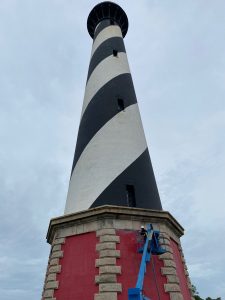
The Cape Hatteras Lighthouse will undergo a complete makeover beginning this spring, and the National Park Service has launched a website to keep the public updated about the renovation.
The 198-story lighthouse’s iconic black and white swirl will be repainted, the metal window frames will be repaired or replaced and the lantern itself may be changed to LED lighting. The park service is also looking into returning the first-order Fresnel lens, which now greets visitors to the Graveyard of the Atlantic Museum nearby.
In October, the National Park Service contracted with Newport News-based HydroPrep to test dry ice blasting to remove paint on a few feet of the lighthouse in Buxton. The method uses dry ice pellets that turn to carbon dioxide gas, leaving behind nothing but original surface.

The National Park Service has received funding for the massive repair project from Congress, and the items that need to be addressed stem from the results of a 2014 Comprehensive Condition Assessment Report, the Island Free Press reported last year.
The lighthouse, designed and constructed in 1868-70, is the tallest brick light tower in the United States. About 500,000 people visit the beacon each year and about 1,500 people climb the lighthouse daily between April and October.
The Hatteras lighthouse and the Bodie Island Lighthouse were both closed to climbing last season due to pandemic restrictions. This year, the Cape Hatteras light may open a brief climbing period later this summer after interior paint inside the structure is removed.
That work is expected to begin in early or mid-March and continue through early summer.
Progress with paint removal and COVID-19 safety requirements will be considered and the Cape Hatteras National Seashore will provide updated communications on the potential for climbing in May.
The full restoration project is scheduled to start later this year after a competitive contracting process and contract award, the National Park Service said. Repair work is expected to take approximately one year to complete.
